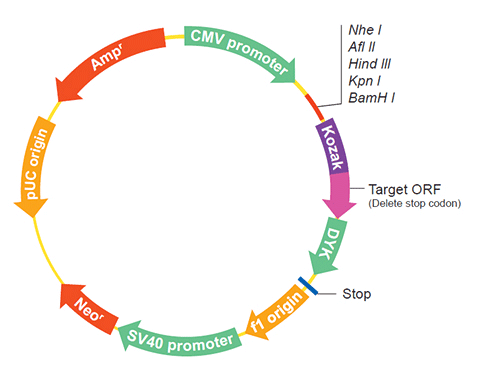| Gene Symbol | OPY2 |
| Entrez Gene ID | 856191 |
| Full Name | Opy2p |
| Gene Type | protein-coding |
| Organism | Saccharomyces cerevisiae S288C |
HOME
ORF » Species Summary » Saccharomyces cerevisiae S288C » OPY2 cDNA ORF clone
| Gene Symbol | OPY2 |
| Entrez Gene ID | 856191 |
| Full Name | Opy2p |
| Gene Type | protein-coding |
| Organism | Saccharomyces cerevisiae S288C |
| mRNA | Protein | Name |
|---|---|---|
| NM_001184172.1 | NP_015400.1 | Opy2p |

| Kluyveromyces lactis | KLLA0B09130g | XP_451935.1 |
| Saccharomyces cerevisiae (baker's yeast) | OPY2 | NP_015400.1 |

The nucleotide sequence of Saccharomyces cerevisiae chromosome XVI.
Bussey H, Storms RK, Ahmed A, Albermann K, Allen E, Ansorge W, Araujo R, Aparicio A, Barrell B, Badcock K, Benes V, Botstein D, Bowman S, Br?ckner M, Carpenter J, Cherry JM, Chung E, Churcher C, Coster F, Davis K, Davis RW, Dietrich FS, Delius H, DiPaolo T, Hani J
Nature387(6632 Suppl)103-5(1997 May)
Life with 6000 genes.
Goffeau A, Barrell BG, Bussey H, Davis RW, Dujon B, Feldmann H, Galibert F, Hoheisel JD, Jacq C, Johnston M, Louis EJ, Mewes HW, Murakami Y, Philippsen P, Tettelin H, Oliver SG
Science (New York, N.Y.)274(5287)546, 563-7(1996 Oct)
GeneRIFs: Gene References Into Functions What's a GeneRIF?
The extracellular cysteine-rich domain of the transmembrane-anchor protein Opy2 binds to the Hkr1-Msb2 homology domain of the putative osmosensor Msb2 and the formation of the Opy2-Msb2 complex is essential for osmotic activation of Hog1.
Title: Binding of the Extracellular Eight-Cysteine Motif of Opy2 to the Putative Osmosensor Msb2 Is Essential for Activation of the Yeast High-Osmolarity Glycerol Pathway.
Dynamic regulation of Ste50-Opy2 interaction fine-tunes the MAPK signaling network.
Title: Dynamic control of yeast MAP kinase network by induced association and dissociation between the Ste50 scaffold and the Opy2 membrane anchor.
Two peptide motifs within the intrinsically disordered cytoplasmic tail of Opy2p physically interact with the Step50p-RA domain.
Title: Binding the atypical RA domain of Ste50p to the unfolded Opy2p cytoplasmic tail is essential for the high-osmolarity glycerol pathway.
The following OPY2 gene cDNA ORF clone sequences were retrieved from the NCBI Reference Sequence Database (RefSeq). These sequences represent the protein coding region of the OPY2 cDNA ORF which is encoded by the open reading frame (ORF) sequence. ORF sequences can be delivered in our standard vector, pcDNA3.1+/C-(K)DYK or the vector of your choice as an expression/transfection-ready ORF clone. Not the clone you want? Click here to find your clone.
| CloneID | OSi05030 | |
| Clone ID Related Accession (Same CDS sequence) | NM_001184172.1 | |
| Accession Version | NM_001184172.1 Latest version! | Documents for ORF clone product in default vector |
| Sequence Information | ORF Nucleotide Sequence (Length: 1083bp) Protein sequence SNP |
|
| Vector | pcDNA3.1-C-(k)DYK or customized vector |  User Manual User Manual |
| Clone information | Clone Map |  MSDS MSDS |
| Tag on pcDNA3.1+/C-(K)DYK | C terminal DYKDDDDK tags | |
| ORF Insert Method | CloneEZ™ Seamless cloning technology | |
| Insert Structure | linear | |
| Update Date | 2019-10-31 | |
| Organism | Saccharomyces cerevisiae S288C | |
| Product | Opy2p | |
| Comment | Comment: REVIEWED REFSEQ: This record has been curated by SGD. This record is derived from an annotated genomic sequence (NC_001148). ##Genome-Annotation-Data-START## Annotation Provider :: SGD Annotation Status :: Full Annotation Annotation Version :: R64-2-1 URL :: http://www.yeastgenome.org/ ##Genome-Annotation-Data-END## COMPLETENESS: incomplete on both ends. | |
1 | ATGTCGAGCT CCTCCAAGGC TTCTGCAAGT TCATCCTTGT CAAGCACAGC CACCTCTTCA |
The stop codons will be deleted if pcDNA3.1+/C-(K)DYK vector is selected.
| RefSeq | NP_015400.1 |
| CDS | 1..1083 |
| Translation |

Target ORF information:
Target ORF information:
|
 NM_001184172.1 NM_001184172.1 |

1 | ATGTCGAGCT CCTCCAAGGC TTCTGCAAGT TCATCCTTGT CAAGCACAGC CACCTCTTCA |
The stop codons will be deleted if pcDNA3.1+/C-(K)DYK vector is selected.
The nucleotide sequence of Saccharomyces cerevisiae chromosome XVI. |
Life with 6000 genes. |